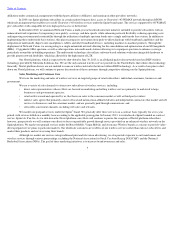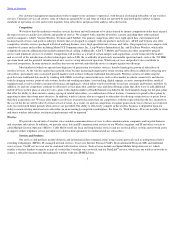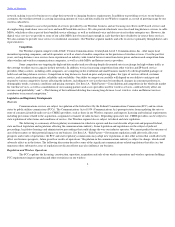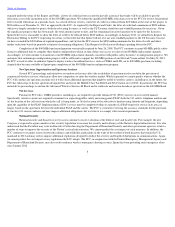Sprint - Nextel 2012 Annual Report Download - page 17
Download and view the complete annual report
Please find page 17 of the 2012 Sprint - Nextel annual report below. You can navigate through the pages in the report by either clicking on the pages listed below, or by using the keyword search tool below to find specific information within the annual report.
Table of Contents
operations and reduced cash flow from operations associated with initiation of service for these devices until such time that retail service revenues
associated with customers acquiring these devices exceeds such costs.
We expect to incur expenses to attract new subscribers, improve subscriber retention and reduce churn, but there can be no assurance that
our efforts will result in new subscribers or a lower rate of subscriber churn. Subscriber losses and a high rate of churn adversely affect our business,
financial condition and results of operations because they result in lost revenues and cash flow. Although attracting new subscribers and retention of
existing subscribers are important to the financial viability of our business, there is an added focus on retention because the cost of adding a new
subscriber is higher than the cost associated with retention of an existing subscriber.
As the wireless market matures, we must increasingly seek to attract subscribers from competitors and face increased credit risk from new
postpaid wireless subscribers.
We and our competitors increasingly must seek to attract a greater proportion of new subscribers from each other's existing subscriber
bases rather than from first
-
time purchasers of wireless services. In addition, the higher market penetration also means that subscribers purchasing
postpaid wireless services for the first time, on average, have lower credit scores than existing wireless subscribers, and the number of these
subscribers we are willing to accept is dependent on our credit policies, which may be different than our competitors. To the extent we cannot compete
effectively for new subscribers or if they are not creditworthy, our revenues and results of operations will be adversely affected.
The Merger Agreement contains provisions that could affect the decisions of a third party considering making an alternative acquisition proposal
to the SoftBank Merger.
On October 15, 2012, Sprint entered into the Merger Agreement with SoftBank, Starburst I, Inc., a Delaware corporation and a direct wholly
owned subsidiary of SoftBank (HoldCo), Starburst II, Inc., a Delaware corporation and a direct wholly owned subsidiary of HoldCo (Parent), and
Starburst III, Inc., a Kansas corporation and a direct wholly owned subsidiary of Parent (Merger Sub and, together with SoftBank, HoldCo, Parent, the
"SoftBank Entities"), pursuant to which, at the effective time of the Merger (Effective Time), Merger Sub will merge with and into the Company, with
the Company surviving the merger as a wholly owned subsidiary of Parent (SoftBank Merger). Upon consummation of the SoftBank Merger, Parent
will be renamed Sprint Corporation (New Sprint).
Under the terms of the Merger Agreement, in certain circumstances Sprint may be required to pay to SoftBank a termination fee of $600
million, or to pay certain fees of the SoftBank Entities up to a maximum of $75 million, in connection with termination of the Merger Agreement. In
addition, the Merger Agreement limits the ability of Sprint to initiate, solicit, encourage or facilitate acquisition or merger proposals from a third party.
These provisions could affect the decision by a third party to make a competing acquisition proposal, or the structure, pricing and terms proposed by
a third party seeking to acquire or merge with Sprint.
Pending litigation against Sprint, SoftBank and Clearwire could result in an injunction preventing the completion of the SoftBank Merger or the
Clearwire Acquisition and the payment of damages in the event the SoftBank Merger or the Clearwire Acquisition are completed and may
adversely affect New Sprint's business, financial condition or results of operations following the SoftBank Merger or the Clearwire Acquisition.
In connection with the SoftBank Merger and as of the date of this Form 10
-
K, purported stockholders of Sprint have filed several
stockholder class action complaints against Sprint, its directors and the SoftBank Entities alleging, among other things, that the Sprint board of
directors conducted an unfair sales process resulting in unfair consideration to the Sprint stockholders in the SoftBank Merger. The complaints assert
that members of Sprint's board of directors breached their fiduciary duties in agreeing to the SoftBank Merger and in agreeing to the issuance of the
convertible bond (Bond) pursuant to the Bond Purchase Agreement dated October 15, 2012 between Sprint and Parent, and that SoftBank aided and
abetted these alleged breaches of fiduciary duties. The lawsuits seek to enjoin the SoftBank Merger and seek unspecified monetary damages.
On December 17, 2012, Sprint announced that it had agreed to acquire all of the equity interests of Clearwire Corporation (together with
Clearwire Communications LLC,
“
Clearwire
”
)
not currently owned by Sprint (Clearwire Acquisition), subject to the terms and conditions of the
agreement and plan of merger, dated as of December 17, 2012, by and among Sprint, Clearwire Corporation and Collie Acquisition Corp. (Clearwire
Acquisition Agreement). In connection with the Clearwire Acquisition and as of the date of this Form 10
-
K,
14
























